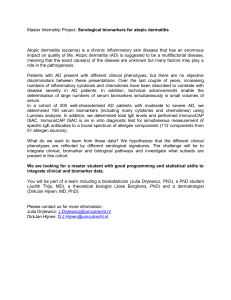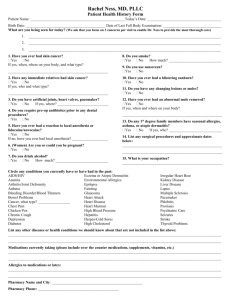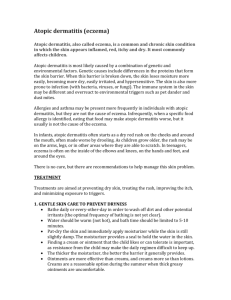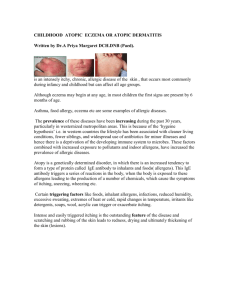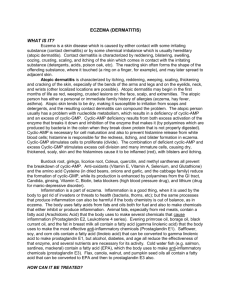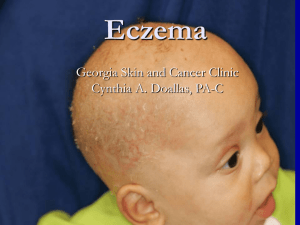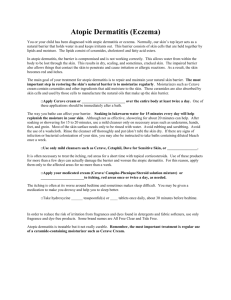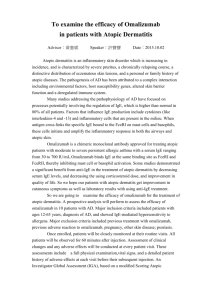En esta edición le enviamos una extensa revisión bibliografica de
advertisement
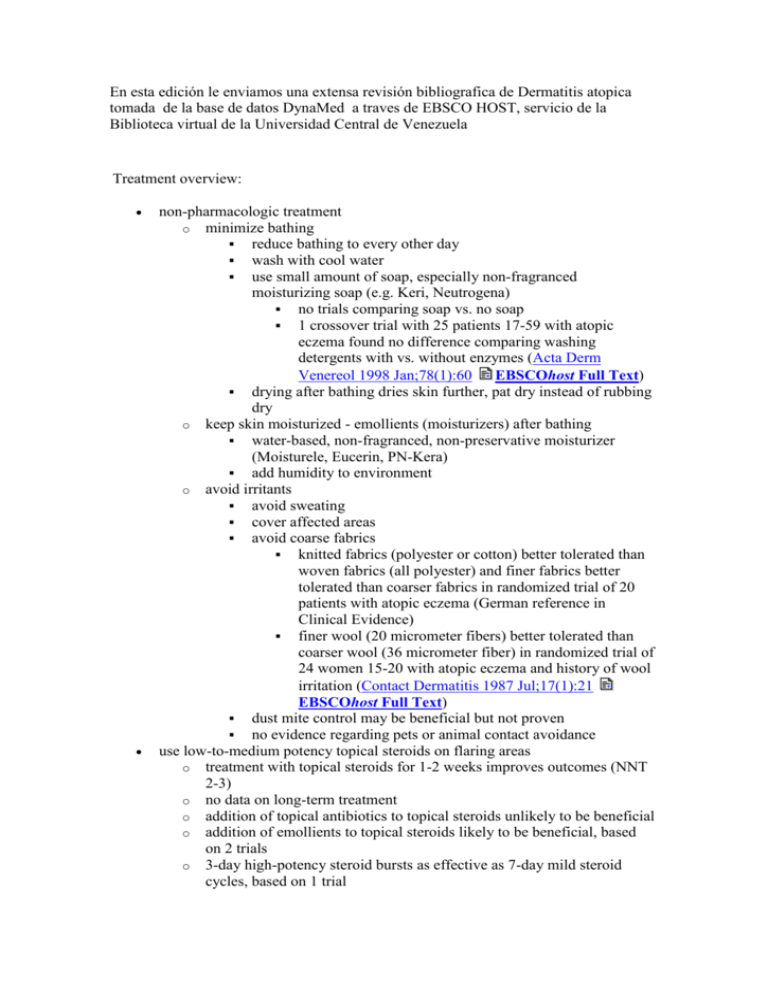
En esta edición le enviamos una extensa revisión bibliografica de Dermatitis atopica tomada de la base de datos DynaMed a traves de EBSCO HOST, servicio de la Biblioteca virtual de la Universidad Central de Venezuela Treatment overview: non-pharmacologic treatment o minimize bathing reduce bathing to every other day wash with cool water use small amount of soap, especially non-fragranced moisturizing soap (e.g. Keri, Neutrogena) no trials comparing soap vs. no soap 1 crossover trial with 25 patients 17-59 with atopic eczema found no difference comparing washing detergents with vs. without enzymes (Acta Derm Venereol 1998 Jan;78(1):60 EBSCOhost Full Text) drying after bathing dries skin further, pat dry instead of rubbing dry o keep skin moisturized - emollients (moisturizers) after bathing water-based, non-fragranced, non-preservative moisturizer (Moisturele, Eucerin, PN-Kera) add humidity to environment o avoid irritants avoid sweating cover affected areas avoid coarse fabrics knitted fabrics (polyester or cotton) better tolerated than woven fabrics (all polyester) and finer fabrics better tolerated than coarser fabrics in randomized trial of 20 patients with atopic eczema (German reference in Clinical Evidence) finer wool (20 micrometer fibers) better tolerated than coarser wool (36 micrometer fiber) in randomized trial of 24 women 15-20 with atopic eczema and history of wool irritation (Contact Dermatitis 1987 Jul;17(1):21 EBSCOhost Full Text) dust mite control may be beneficial but not proven no evidence regarding pets or animal contact avoidance use low-to-medium potency topical steroids on flaring areas o treatment with topical steroids for 1-2 weeks improves outcomes (NNT 2-3) o no data on long-term treatment o addition of topical antibiotics to topical steroids unlikely to be beneficial o addition of emollients to topical steroids likely to be beneficial, based on 2 trials o 3-day high-potency steroid bursts as effective as 7-day mild steroid cycles, based on 1 trial o twice-weekly fluticasone propionate (0.05% cream) to usually affected areas reduced relapse rates in randomized trial of 295 patients stabilized on 4 weeks of fluticasone propionate topical immunosuppressants may be useful in refractory cases o topical tacrolimus (Protopic) 0.1% and 0.03% twice daily effective but associated with 47% burning and 24% itching, approved for moderate to severe atopic dermatitis o pimecrolimus 1% (Elidel) cream twice daily associated with less burning and itching, approved for mild to moderate atopic dermatitis o BOXED warning added to product labels of Elidel and Protopic regarding possible cancer risk many treatments have been studied for severe atopic dermatitis, and several have limited supporting evidence, details below Diet: insufficient evidence to recommend dietary manipulation o exclusion diet (but consider impact on patient's lifestyle) systemic reviews of exclusion diets find few randomized trials 1 randomized trial with 17 infants found no benefit 2 randomized trials with 43 evaluable adults found no benefit 2 randomized trials in children had conflicting results 1 crossover trial of 20 children 2-8 reported 70% vs. 5% improvement with egg and milk exclusion diet 1 crossover trial of 40 children and young adults found no significant effect Reference - Clinical Evidence generally not considered useful in pediatric practice and not widely practiced should be reserved for highly motivated patients with eczema that does not respond to conventional treatment approach for exclusion diet test by elimination and challenge by re-introduction simple exclusion - #1 milk (up to 7.5% young children have cow milk allergy) follow-up 6 weeks then challenge for multiple exclusion diets, see Practitioner 1994 Apr 11;238:281 a few children with atopic dermatitis may benefit from restricted diet, mainly if elimination diet started in first year of life (J R Soc Med 1997;90 Suppl 30:9 PDF in BMJ 1997 May 24;314(7093):1562) avoidance of food additives may be helpful in highly selected adults; study of 41 adults with atopic dermatitis, allergy to at least 1 common aeroallergen and mean IgE level 1,900 underwent open-label pseudoallergen elimination diet for 6 weeks, 26 (63%) had improvement in skin disease severity; 24 responders were rechallenged with pseudoallergen-rich diet for 2 days and 19 had worsening of rash after 24-hour delay, 10 nonresponders were rechallenged and none worsened; 15 who responded to open challenge underwent double-blind challenge with food additives and 6 developed increased rash after 24-hour delay, 10 initial nonresponders had no response to controlled food additive challenge (Clin Exp Allergy 2000 Mar;30(3):407 EBSCOhost Full Text in QuickScan Reviews in Fam Pract 2001 Apr;26(2):18) o fatty acid supplementation (gamma-linolenic acid, evening primrose oil, borage oil) NOT effective fish oil contains n-3 polyunsaturated fatty acids EPA and DHEA and may have anti-inflammatory properties high-dose gamma-linolenic acid not effective; 151 patients with atopic dermatitis randomized to borage oil 4 capsules twice daily (gamma-linolenic acid 920 mg/day) (2 capsules twice daily in children) vs. placebo for 12 weeks; 140 patients (69 children) were followed; mean disease activity scores decreased from 30 to 27 with borage oil and 28 to 23 with placebo, differences favored placebo but were not statistically significant (BMJ 2003 Dec 13;327(7428):1385), editorial can be found in BMJ 2003 Dec 13;327(7428):1358 evening primrose oil (Epogam 6 g/day or 12 tablets/day, active ingredient gamma-linolenic acid 600 mg/day) ineffective in well-conducted placebo-controlled trials despite earlier benefits reported in manufacturer-reported "meta-analysis" of poorly conducted studies (Br J Dermatol 1989 Jul;121(1):75 EBSCOhost Full Text); evening primrose oil relatively harmless but may lower seizure threshold when used with anticonvulsants (Alternative Medicine Alert 1999 Jan;2(1):8) for infant atopic dermatitis with breastfeeding mother o insufficient evidence to recommend dietary antigen avoidance during lactation systematic review of 2 randomized or quasi-randomized trials of maternal dietary antigen avoidance during lactation no significant protective effect on incidence of atopic eczema in child during first 18 months in 1 trial with 26 lactating women nonsignificant reduction in eczema severity in 1 crossover trial with 17 lactating mothers of infants with established atopic eczema Reference - systematic review last updated 2006 Apr 24 (Cochrane Library 2006 Issue 3:CD000133) o discontinuing breastfeeding should be considered if infant's eczema not controlled with maternal elimination diet (grade B recommendation [inconsistent or limited evidence]) 100 Finnish infants developed moderate to severe eczema during exclusive breastfeeding and mothers used various elimination diets 41 infants also had gastrointestinal symptoms severity of eczema decreased after discontinuation of breastfeeding risk of poor growth associated with duration of breastfeeding Reference - J Pediatr 1999 Jan;134(1):27 in J Watch 1999 Feb 15;19(4):34 on discontinuing breastfeeding, infants were weaned to synthetic amino acid derived formula (in Pediatric Notes 1999 Feb 18;23(7):26) Counseling: education of patients and parents may improve control of atopic dermatitis (level 2 [mid-level] evidence) o Click for Details 992 families with children aged 3 months to 18 years with atopic dermatitis for at least 3 months (stratified by 3 age groups) were randomized to intervention vs. control for 12 months intervention consisted of 6 weekly manual-based group educational sessions lasting 2 hours each sessions covered medical, nutritional and psychological issues and were provided by dermatologists, pediatricians, psychologists, dietitians and nurses sessions were grouped by patient age for children ages 3 months to 7 years, sessions attended by parents for children ages 8-12 years, sessions attended by parents and children for adolescents ages 12-18 years, sessions attended by adolescents with parents optional for first 2 sessions 823 families (83%) evaluated at 12 months, dropout rates 10% intervention group and 24% control group, no intent to treat analysis atopic dermatitis total severity score decreased in all patients but significantly greater decrease with intervention for children ages 3 months to 7 years, mean score decreased from 41.1 to 23.7 with intervention vs. from 40.6 to 28.4 with control (p = 0.0002) for children ages 8-12 years, mean score decreased from 41.8 to 25.8 with intervention vs. from 40.4 to 32.6 with control (p = 0.003) for adolescents, mean score decreased from 43.1 to 23.4 with intervention vs. from 40.4 to 35.2 with control (p < 0.0001) similar patterns for objective and subjective severity scores in all age groups Reference - BMJ 2006 Apr 22;332(7547):933 full-text, editorials can be found in BMJ 2006 Apr 22;332(7547):923 and in BMJ 2006 Apr 22;332(7547):936 Medications: topical steroids are beneficial o low-to-medium potency topical steroids recommended o small short-term trials have found that topical steroids applied for 1-4 weeks improve atopic dermatitis 10 trials all found significant improvement with topical steroids compared to placebo, 2 largest trials were 233 patients 2-67 with atopic dermatitis randomized to halcinonide 0.1% vs. placebo ointment 3 times daily for 2 weeks, 85% vs. 44% had excellent or good response (NNT 2.4) (Clin Ther 1997 Jul-Aug;19(4):710) 194 patients 17-76 with atopic dermatitis randomized to hydrocortisone buteprate 0.1% vs. placebo cream once daily for 2 weeks, 69% vs. 26% had excellent or good response (NNT 2.3) (Cutis 1982 Nov;30(5):671) 35 comparison trials of various topical steroids found improvements in 22-100% patients after 1-6 weeks but no clear evidence suggesting differences between steroids fluticasone propionate 0.05% lotion (Cutivate Lotion) once daily for 4 weeks reported to be safe and effective in 2 randomized placebo-controlled trials with 438 patients ages 3 months to 87 years with atopic dermatitis, trials limited to 4 weeks duration (J Am Acad Dermatol 2006 Apr;54(4):715) o 3-day high-potency steroid bursts as effective as 7-day mild steroid cycles 207 children with mild or moderate atopic eczema randomized to 3-day high-potency steroids (0.1% betamethasone valerate applied twice daily for 3 days then base ointment for 4 days) vs. 7-day mild-potency steroids (1% hydrocortisone applied twice daily for 7 days) to be used as needed for flares of atopic eczema over 18 weeks no differences in total number of scratch-free days (median 117.5 vs. 118), number of relapses (median 1 vs. 1), median duration of relapses, number of undisturbed nights, disease severity or quality of life measures (improvement in both groups) Reference - BMJ 2002 Mar 30;324(7340):768, commentary can be found in Am Fam Physician 2002 Aug 15;66(4):676 o most patients with atopic dermatitis adequately controlled with topical steroids; retrospective study of 1,271 patients with atopic dermatitis followed for 6 months, most controlled well; severe disease or exacerbations despite larger amounts of topical steroids occurred in 7% infants, 10% children, and 19% adolescents and adults; adverse effects included telangiectasias on cheeks (especially in patients using > 20 g on face over 6 months) and atrophy of antecubital and popliteal fossae (more common in males) (Br J Dermatol 2003 Jan;148(1):128 EBSCOhost Full Text) o once-daily dosing appears adequate for potent topical steroids (level 2 [mid-level] evidence) (* further peer review in progress) based on systematic review with heterogeneity o o o o systematic review of 10 randomized trials comparing once-daily dosing with more frequent dosing of topical steroids in 1,819 patients with atopic eczema, 8 of 10 trials studied potent steroids meta-analysis not done due to heterogeneity 7 trials evaluated outcome of "at least a good response or 50% improvement", only 1 of which found benefit for more frequent dosing 6 trials assessed outcome of "eczema cleared or controlled", only 1 of which found benefit for more frequent dosing Reference - Br J Dermatol 2005 Jan;152(1):130 EBSCOhost Full Text in J Fam Pract 2005 Jun;54(6):499 EBSCOhost Full Text or in Am Fam Physician 2005 Jul 1;72(1):150 limiting use of corticosteroid creams to once daily for atopic dermatitis recommended to reduce local side effects without loss of efficacy (BMJ 2007 Jun 16;334(7606):1272) twice-weekly topical fluticasone propionate reduces relapse rate; 376 patients 12-65 years old with flare of moderate to severe atopic dermatitis were treated with fluticasone propionate 0.05% cream or 0.005% ointment once daily or twice daily for 4 weeks, 71% to 84% of these 4 groups successfully completed stabilization phase; 295 patients who had stabilization of dermatitis were treated with emollient (cetomacrogol cream) twice daily with bath oil as needed and randomized to fluticasone propionate vs. placebo cream or ointment twice weekly to areas that were usually affected for 16 weeks; 40 of 138 (29%) fluticasone vs. 95 of 157 (60.5%) placebo users had relapse (NNT 3.2); fluticasone cream may be more effective (18.6% relapse rate) than fluticasone ointment (39.7% relapse rate) (BMJ 2003 Jun 21;326(7403):1367), editorial can be found in BMJ 2003 Oct 25;327(7421):942 adverse effects skin thinning - potent topical steroid preparations cause skin thinning after application twice daily for 6 weeks, but skin thickness returns to normal within 4 weeks after discontinuation, based on 4 studies in 12 healthy volunteers no serious or systemic effects or cases of skin atrophy reported in short-term trials minor adverse effects occurred in < 10% patients and include burning, stinging, irritation, folliculitis, hypertrichosis, contact dermatitis, pigmentary disturbances little information regarding long-term use insufficient evidence to recommend once-daily vs. more frequent use of topical steroids; systematic review of 10 randomized trials found evidence based limited to potent corticosteroids in patients with moderate to severe atopic dermatitis, while most patients have mild atopic dermatitis (Health Technol Assess 2004 Nov;8(47):1 full-text) allergic reactions to corticosteroids can occur; case report of anaphylaxis in women with atopic dermatitis after taking oral prednisolone; skin testing showed immediate type reactions to prednisolone, prednisolone hydrogen succinate, prednisone, and betamethasone dihydrogen phosphate; challenge testing showed tolerability for methylprednisolone and dexamethasone (J Am Board Fam Pract 2005 Mar-Apr;18(2):143 full-text) o NICE guidance on frequency of application of topical corticosteroids for atopic eczema recommended to be prescribed for application only once or twice daily within a potency class, prescribe drug with lowest cost, taking into account pack size and frequency of application Reference - National Guideline Clearinghouse 2005 Nov 28:8118 or at NICE 2004 Aug:TA81 addition of topical antibiotics to topical steroids unlikely to be beneficial o topical antimicrobial-steroid combinations usually reserved for clinically infected eczema, but not shown to be beneficial o 3 randomized trials found no significant differences comparing steroid/antibiotic vs. steroid alone 186 patients with atopic dermatitis (not necessarily infected) randomized to hydrocortisone vs. hydrocortisone-fusidic acid for 2 weeks, no significant difference in clinical signs and symptoms (J Eur Acad Dermatol Venereol 1996;7(suppl 1):S15) 60 patients with clinically infected atopic dermatitis randomized (by side of body) to betamethasone vs. betamethasone-fusidic acid for 1 week, no significant difference in clinical signs and symptoms (Pharmatherapeutica 1985;4(2):126) combination of betamethasone valerate and gentamicin reported to be more effective than topical steroid alone but differences not significant according to Clinical Evidence review (Br J Dermatol 1976 Sep;95(3):323 EBSCOhost Full Text) o 5 comparison trials of antimicrobial-steroid combinations in clinically infected eczema found no significant differences in clinical improvement, but some measures responded better to fusidic acid than miconazole or clioquinol as antimicrobial agent addition of emollients to topical steroids likely to be beneficial o 80 children and adults with mild to moderate atopic eczema randomized to adding moisturizing cream 3 times daily to desonide 0.05% twice daily vs. desonide alone for 3 weeks, 70% vs. 55% had additional significant improvement (NNT 6.7) (Clin Ther Res 1998;589:227) o 50 patients taking hydrocortisone 2.5% cream once daily were randomized to emollient cream vs. emollient lotion for 3 weeks, both groups had significant improvement (Today Ther Trend 1993;11:157) aqueous creams have high rate of adverse effects in children with atopic dermatitis; in series of 100 such children 56% of exposures to aqueous creams (vs. 18% exposures to other emollients) resulted in burning, stinging, itching or redness within 20 minutes (Pharmaceutical Journal 2003;271:747 in BMJ 2003 Dec 13;327(7428):1414) review of topical therapies used in pediatrics o moisturization often sufficient to treat symptomatic dryness seen with dermatitis o lotions convenient and can be easily applied, but often contain alcohol and may sting when applied to nonintact skin o creams have high patient acceptance, frequent addition of perfumes and other products can exacerbate irritated skin o ointments are greasy and most effective for extremely dry skin o gels have high alcohol content so may burn and sting; ideal uses of gels include treatment of hair-bearing areas and intraoral disorders, and delivery of benzoyl peroxide for acne o solutions can be used for dermatoses affecting hairy areas o powders rarely helpful for dermatoses o pastes best used as barriers and protectants, such as zinc oxide paste for diaper dermatitis o keratolytic agents can soften thickened stratum corneum to give softer skin o Reference - Pediatr Ann 1998 Mar;27(3):171 in QuickScan Reviews in Fam Pract 1998 Oct;23(7):7 antihistamines o insufficient evidence to support or refute efficacy of antihistamines; systematic literature review identified 16 trials but most of very poor quality or sample size < 20, 2 small placebo-controlled crossover trials (20-30 patients each) of terfenadine and clemastine found no benefit for antihistamines, parallel group trial of cetirizine with 178 patients found benefit with reduced pruritis (and increased sedation) in 13 patients taking higher (40 mg) dose (Arch Dermatol 1999 Dec;135(12):1522 in POEMs in J Fam Pract 2000 Mar;49(3):267) o long-term cetrizine appears safe in young children but not clearly effective; 795 children 12-24 months old with active atopic dermatitis for at least 1 month and first-degree relative with atopic disease were randomized to cetirizine 0.25 mg/kg vs. placebo PO twice daily for 18 months; both groups had statistically significant reduction in severity of atopic dermatitis over time, but no significant difference between groups; 19% vs. 25% were treated with additional oral antihistamines (p = 0.03), no difference in overall topical steroid use but moderate-tostrong topical steroids were used on 18% vs. 25% of days (p = 0.067); 5.8% vs. 16% developed urticaria (p < 0.001); no differences in adverse effects (Pediatr Allergy Immunol 2002 Aug;13(4):278 EBSCOhost Full Text in Pediatrics 2003 Aug;112(2 Suppl):462) macrolactams - tacrolimus (Protopic) and pimecrolimus (Elidel) o FDA issued public health advisory that tacrolimus and pimecrolimus may have cancer risk based on animal studies and case reports, but human studies may take 10 years or more to determine cancer risk (FDA MedWatch 2005 Mar 10, FDA Talk Paper 2005 Mar 10); BOXED warning added to product labels of Elidel and Protopic (FDA Press Release 2006 Jan 19) o labeling for Elidel and Protopic clarified that they are not recommended as first-line therapy and not recommended for children < 2 years old (Monthly Prescribing Reference 2006 Mar:A-10) o topical pimecrolimus and tacrolimus each more effective than placebo (level 1 [likely reliable] evidence) but comparative data with corticosteroids limited systematic review of 25 randomized trials of topical tacrolimus or pimecrolimus in 6,897 patients with atopic dermatitis, o primary outcome used for this review was proportion of patients reaching clear or almost clear (or at least 90% clear) compared with placebo pimecrolimus 1% increased rates of clear or almost clear at 3 weeks (based on 5 trials) and 6 weeks (3 trials) tacrolimus 0.03% increased rates of at least 90% clear at 3 weeks (1 trial) and 12 weeks (3 trials) tacrolimus 0.1% increased rates of at least 90% clear at 12 weeks (3 trials) but not statistically significant at 3 weeks (1 trial) all placebo-controlled trials were limited by high dropout rates (lack of efficacy) in placebo groups compared with topical corticosteroids pimecrolimus 1% less effective than betamethasone valerate 0.1% at 3 weeks (based on 1 trial) tacrolimus 0.03% more effective than hydrocortisone acetate 1% at 3 weeks (2 trials), less effective than hydrocortisone butyrate 0.1% at 3 weeks (1 trial) tacrolimus 0.1% more effective than hydrocortisone acetate 1% at 3 weeks (1 trial), more effective than hydrocortisone butyrate 0.1%/hydrocortisone acetate 1% at 12 weeks (1 trial), and no significant difference compared with hydrocortisone butyrate 0.1% at 3 weeks (1 trial) only 1 trial (141 patients) compared tacrolimus 0.03% with pimecrolimus 1% and did not find statistically significant differences in primary outcome no long-term outcome data reported Reference - BMJ 2005 Mar 5;330(7490):516 full-text topical tacrolimus tacrolimus (Protopic) ointment 0.1% and 0.03% FDA approved for eczema refractory to standard therapies (FDA Talk Paper 2000 Dec 8) general information on tacrolimus ointment an effective alternative to topical steroids which does not cause skin atrophy associated with increased risk for skin tumors and lymphoma in mice cost of 0.03% formulation is $54.37 for 30 g and $108.75 for 60 g, cost of 0.1% formulation is $58.12 for 30 g and $116.25 for 60 g Reference - The Medical Letter 2001 Apr 16;43(1102):33 only 0.03% strength FDA approved for children ages 2-15 years, do not use in presence of infection, widespread use may interact with CYP3A4 inhibitors (e.g. erythromycin, cimetidine, ketoconazole) (Monthly Prescribing Reference 2001 Feb:A-9) tacrolimus ointment 0.03% appears safe and effective shortterm in mild to moderate pediatric atopic dermatitis; 317 children ages 2-15 years with mild to moderate atopic dermatitis were randomized to tacrolimus 0.03% vs. vehicle ointment twice daily for 6 weeks; 50.6% vs. 25.8% were treated successfully based on Investigators' Global Atopic Dermatitis Assessment (NNT 4), 54.8% vs. 20.8% improvement from baseline in eczema area and severity index scores; no significant adverse effects (Pediatrics 2005 Sep;116(3):e334 full-text), commentary can be found in Pediatrics 2006 Jun;117(6):2325 topical tacrolimus (FK 506) ointment effective for short-term treatment of atopic dermatitis; 213 patients randomized to tacrolimus ointment 0.03%, 0.1%, 0.3% or vehicle alone twice daily to defined symptomatic area; median percentage decrease for summary score of erythema, edema and pruritus was 66.7%, 83.3%, 75% and 22.5%; 47% tacrolimus patients and 15% placebo patients had burning at site of application (N Engl J Med 1997 Sep 18;337(12):816), commentary can be found in N Engl J Med 1998 Dec 10;339(24):1788 topical tacrolimus ointment can be used safely and effectively for up to 1 year 316 patients > 18 years old with moderate to severe atopic dermatitis treated with tacrolium 0.1% ointment and followed for 6-12 months adverse events included 47% burning, 24% pruritus, 12% erythema but tended to resolve with continuing treatment no marked changes in laboratory values, maximum tacrolimus blood level < 1 ng/mL in 76% patients Reference - Arch Dermatol 2000 Aug;136(8):999 in JAMA 2000 Nov 15;284(19):2435 DynaMed commentary - unknown from abstract how high tacrolimus blood level was in 24% patients and if this could be clinically significant tacrolimus ointment FDA approved; most common adverse effects have been transient burning and pruritus at application site; 2 studies suggest efficacy in children; 351 children ages 2-5 years with moderate to severe atopic dermatitis randomized to tacrolimus 0.03% vs. 0.1% vs. placebo ointment for 12 weeks, tacrolimus group had clinical improvement of 90% or better; 255 children ages 2-15 years with moderate to severe atopic dermatitis treated with tacrolimus 0.1% twice daily for up to 12 months, efficacy maintained and burning and itching decreased after first few days; entire journal supplement supported by drug manufacturer (J Am Acad Dermatol 2001 Jan;44(1 Suppl):S1 in Pediatric Notes 2001 Jan 25;25(4):13) tacrolimus 0.1% ointment appears effective for pityriasis alba (level 2 [mid-level] evidence) based on open-label randomized trial 60 patients ages 6-21 years randomized to tacrolimus ointment 0.1% twice daily vs. no tacrolimus ointment for 9 weeks both groups had moisturizers with sunscreen analysis limited to 50 patients who completed the study o tacrolimus had greater benefit for hypopigmentation, lesser benefit for pruritus and no benefit for scaling Reference - Br J Dermatol 2006 Jul;155(1):152 EBSCOhost Full Text in Am Fam Physician 2006 Dec 1;74(11):1939 concerns regarding use of tacrolimus include systemic absorption which is known to occur with topical tacrolimus; systemic tacrolimus associated with increased susceptibility to infection, possible development of lymphoma, neurological dysfunction, hypertension, renal toxicity, hyperglycemia, electrolyte imbalance; advice to reserve topical tacrolimus (Protopic) for second-line use in severe disease unresponsive to standard therapies, control infection before starting tacrolimus, use 0.03% strength, monitor blood levels, ensure sun protection, avoid long-term maintenance therapy with tacrolimus (Pediatric Notes 2001 Jun 7;25(23):89); commentary notes that oral tacrolimus (Prograf) cautions should not be applied to topical tacrolimus (Protopic) and that tacrolimus ointment may be preferred as first-line agent instead of topical corticosteroids, especially for atopic dermatitis of face, groin or axillae (Pediatric Notes 2001 Aug 30;25(35):139) review of topical tacrolimus can be found in Am Fam Physician 2002 Nov 15;66(10):1899, commentary can be found in Am Fam Physician 2003 May 1;67(9):1874 pimecrolimus (Elidel) pregnancy category C pimecrolimus 1% cream (Elidel) recommended in Australia for facial atopic dermatitis in adults or children when topical corticosteroids are contraindicated or fail to control disease with intermittent use (NPS RADAR 2006 Dec) (* further peer review in progress) pimecrolimus 1% (Elidel) cream applied twice daily until resolved FDA approved for short-term and intermittent longterm treatment of mild to moderate atopic dermatitis in nonimmunocompromised patients aged 2 years and older more effective than placebo but less effective than mediumpotency topical corticosteroid in randomized trials transient skin irritation common; less common adverse effects include eczema herpeticum (< 1%), fever and minor infections (in infants treated for > 6 weeks); associated with lymphoma in mice with very high topical doses sun protection (avoidance, sunscreen) recommended as pimecrolimus and tacrolimus increase skin tumor response to UV light in mice cost of Elidel 1% is $25.02 for 15 g, $47.52 for 30 g, $150 for 100 g; cost of tacrolimus (Protopic) 0.1% is $64.09 for 30 g Reference - The Medical Letter 2002 May 27;44(1131):48 pimecrolimus associated with less burning and itching than tacrolimus, review of tacrolimus and pimecrolimus can be found in J Am Acad Dermatol 2002 Feb;46(2):228 (Pediatric Notes 2002 Feb 28;26(9):33) pimecrolimus 1% (Elidel) costs less than tacrolimus (Protopic) but more than topical corticosteroids; may cause skin warmth, burning sensation or photosensitivity (Prescriber's Letter 2002 Mar;9(3):15) pimecrolimus reduces flares over 1 year of treatment 713 children 2-17 years (mean age 8 years) were randomized to pimecrolimus 1% vs. vehicle cream to be used twice daily from first sign (e.g. erythema) or symptom (e.g. pruritus) until complete clearance of signs and symptoms of atopic dermatitis, both groups were treated with emollients for dry skin and moderately potent topical corticosteroids for severe flares (followed by 1 week of study drug) 24% vs. 48% discontinued study by 6 months (8.9% vs. 27.4% due to lack of efficacy, NNT 5.4), 32% vs. 52% discontinued study by 12 months (12% vs. 30% due to lack of efficacy, NNT 5.6) comparing pimecrolimus vs. vehicle cream among study completers, 61% vs. 34.2% had no flares at 6 months (NNT 3.7), 50.8% vs. 28.3% had no flares at 12 months (NNT 4.4), pimecrolimus reduced number of flares and days using corticosteroid Reference - Pediatrics 2002 Jul;110(1):e2 pimecrolimus effective in young children; 186 children 3-23 months old with mild or moderate atopic dermatitis randomized to pimecrolimus vs. placebo cream twice daily for 6 weeks, 54.5% vs. 23.8% were clear or almost clear at 6 weeks (NNT 3.3); study funded by drug manufacturer (J Pediatr 2003 Feb;142(2):155 in J Watch Online 2003 Mar 14) pimecrolimus may improve parents' quality of life; 6-week randomized placebo-controlled trial of 403 patients 2-17 years old with mild to moderate AD, results limited to 241 children < 8 years old, both groups had improvements from baseline at 6 weeks but pimecrolimus had statistically significant improvements compared to placebo, clinical significance unclear, small but positive associations between parents' quality of life and clinical manifestations of atopic dermatitis (Pediatrics 2002 Dec;110(6):1133 EBSCOhost Full Text) topical 1% pimecrolimus reported to be safe in 4 pharmacokinetic studies and 6 clinical trials involving 1,133 patients ages 3-23 months, most infants followed no longer than 6 months; no infectious diseases were significantly more common with pimecrolimus than placebo but not statistically evaluated for 3 infections that did not occur in any placebo patients, namely stye (3.1 cases per 1,000 patient-months with pimecrolimus), molluscum contagiosum (1.5 cases per 1,000 patient-months) and eczema herpeticum (1.2 cases per 1,000 patient-months) (Pediatrics 2006 Jan;117(1):e118 full-text) tacrolimus (Protopic) may be more effective than pimecrolimus (Elidel) o in children with moderate-to-severe (but not mild) atopic dermatitis 3 trials reported at America Academy of Dermatology meeting 225 children ages 2-16 years with moderate-to-severe atopic dermatitis randomized to tacrolimus 0.2% ointment vs. pimecrolimus 1% cream, 32% vs. 18% had "clear" or "almost clear" skin (NNT 8) 425 children ages 2-16 years with mild atopic dermatitis assigned to tacrolimus 0.03% vs. pimecrolimus 1%, 47% vs. 41% had "clear" or "almost clear" skin (not significant) 313 patients > 16 years old with mild-to-severe eczema assigned to tacrolimus 0.1% vs. pimecrolimus 1%, 46% vs. 27% had "clear" or "almost clear" skin (NNT 6) tacrolimus reduced itching compared to pimecrolimus in all 3 trials Reference - Cortlandt Forum 2004 Sep;17(9):26 o editorial review notes role of tacrolimus and pimecrolimus is unclear as pragmatic comparison trials with topical corticosteroids have not been conducted (BMJ 2002 Jun 29;324(7353):1533), commentary can be found in BMJ 2002 Oct 26;325(7370):970 o review of tacrolimus and pimecrolimus in atopic dermatitis can be found in J Fam Pract 2005 Aug;54(8):714 o NICE guidance on tacrolimus and pimecrolimus for atopic eczema can be found at NICE 2004 Aug:TA82 or at National Guideline Clearinghouse 2005 Nov 21:8119 nonsteroidal dressing (MimyX Cream) FDA approved for burning and itching associated with atopic dermatitis, allergic contact dermatitis, radiation dermatitis and other physician-diagnosed dermatoses in adults and children; hydrogel formulation mimics stratum corneum; FDA approval based on studies showing equivalence to Biafine radiation emulsion and Sinclair wound and skin emulsion (Monthly Prescribing Reference 2005 Nov:A-16, Medscape Medical News 2005 Oct 28) cyclosporine o cyclosporine for severe childhood atopic dermatitis described in trial of 40 children randomized to short course (multiple 12 week courses) vs. continuous therapy for 1 year, continuous therapy provided more consistent results but some patients had prolonged remission with short courses (Br J Dermatol 2000 Jan;142(1):52 EBSCOhost Full Text in Pediatric Notes 2000 Feb 17;24(7):27) o cyclosporine microemulsion (Sandimmune, Neoral) 150 mg/day or 300 mg/day reported as effective in "uncontrolled" randomized trial of 106 adults with severe atopic dermatitis (J Am Acad Dermatol 2000 Apr;42(4):653) o review and consensus regarding cyclosporine for atopic dermatitis can be found in Dermatology 1999;198(2):145 o discussion of cyclosporine in treatment of atopic dermatitis can be found in Mayo Clin Proc 1996 Dec;71(12):1182 azathioprine may be effective for refractory atopic dermatitis o 63 patients adults ages 19-65 years with moderate-to-severe atopic dermatitis despite topical corticosteroids were randomized to azathioprine vs. placebo for 12 weeks o azathioprine dose based on thiopurine methyltransferase (TPMT) enzyme activity which determines myelotoxicity patients with normal TMPT activity given azathioprine 1 mg/kg daily for 4 weeks then 2.5 mg/kg daily patients with heterozygous range TMPT activity given azathioprine 0.5 mg/kg daily for 4 weeks then 1 mg/kg daily o 54 patients (86%) completed the study, 17% azathioprine vs. 10% placebo patients withdrew o mean improvement in disease activity score 37% with azathioprine vs. 20% with placebo o azathioprine associated with significant improvements in itch, area of involvement, global assessment, and quality of life o 2 patients (5%) had drug hypersensitivity with azathioprine o nausea led to drug withdrawal in 4 (9.5%) azathioprine patients and dose reduction in 7 (16.7%) azathioprine patients o Reference - Lancet 2006 Mar 11;367(9513):839 EBSCOhost Full Text probiotic therapy may benefit some children with atopic dermatitis o probiotic therapy may benefit allergic children with atopic dermatitis (level 2 [mid-level] evidence) 58 children aged 1-13 years with atopic dermatitis randomized to probiotics (2 Lactobacillus strains) vs. placebo for 6 weeks, both groups continued topical corticosteroids 43 patients (75%) evaluated at 6 weeks neither group had significant changes in clinical severity score 56% probiotic group vs. 15% placebo group believed their symptoms improved (p = 0.001, NNT 3) among subgroup of children with allergic findings based on serum IgE levels or history of other allergic disorders, baseline clinical score was 37 and decreased by 2.4 with active vs. increased by 3.2 with placebo (p = 0.04) Reference - J Allergy Clin Immunol 2003 Feb;111(2):389 o probiotic therapy may benefit infants with moderate to severe atopic dermatitis (level 2 [mid-level] evidence) 56 children aged 6-18 months with moderate or severe atopic dermatitis randomized to probiotics (Lactobacillus fermentum VRI-033 PCC) vs. placebo twice daily for 8 weeks, 88% of patients using topical corticosteroids at baseline continued topical corticosteroids 53 children evaluated at 16 weeks 92% probiotic vs. 63% placebo group had improvement in atopic dermatitis severity index (p = 0.01, NNT 4) 54% vs. 30% had mild atopic dermatitis (NNT 5) Reference - Arch Dis Child 2005 Sep;90(9):892, commentary can be found in Arch Dis Child 2005 Sep;90(9):881 o Lactobacillus infections rare, and association with probiotics limited to case reports (BMJ 2006 Nov 11;333(7576):1006), commentary can be found in BMJ 2006 Dec 16;333(7581):1272 other therapies with very limited evidence o vitamin E 400 units/day may help but may take up to 8 months for effect o o o o o o 96 patients with moderate to severe atopic dermatitis were randomized to natural vitamin E 400 units vs. placebo PO once daily for 8 months comparing vitamin E vs. placebo 46% vs. 2.2% had great improvement in itching and thickened skin (NNT 2.3) 14% vs. 0 had almost complete remission (NNT 7.2) Reference - Int J Dermatol 2002 Mar;41(3):146 EBSCOhost Full Text in Prescriber's Letter 2002 Sep;9(9):51 DynaMed commentary - natural vitamin E (D-alpha tocopherol, used in this study) significantly more biologically active than synthetic vitamin E (D,L-alpha tocoherol) so 2 products both providing 400 units of vitamin E may not have similar activities oral ketoconazole may reduce symptoms in patients with yeast hypersensitivity; 80 adults (mean age 30) with atopic dermatitis and positive skin prick or RAST tests to Pityrosporum ovale, Candida albicans or Saccharomyces cerevisiae were randomized to ketoconazole 200 mg vs. placebo PO once daily for 30 days, significant improvement in eczema severity reported with ketoconazole but not with placebo at 30 days, no significant benefit reported at 3 months so benefit may disappear with cessation of treatment (Allergy 2001 Jun;56(6):512 EBSCOhost Full Text in QuickScan Reviews in Fam Pract 2002 Sep;27(9):28) leukotriene antagonists (zafirlukast [Accolate] 20 mg twice daily, montelukast [Singulair] 10 mg nightly, zileuton [Zyflo] 600 mg 4 times daily) reported to be effective in small series; most reported side effects were headache and pharyngitis, drug interactions occur with Accolate (Prescriber's Letter 2002 Sep;9(9):51) montelukast 10 mg PO once daily and cimetidine 400 mg PO each evening effectively treated resistant atopic dermatitis in case report of 87-year-old female nursing home resident with lack of efficacy and side effects with high-dose antihistamines and oral corticosteroids; diagnosis unclear given no personal history of asthma, allergic rhinitis or atopy (J Am Geriatr Soc 2001 Jul;49(7):1008) mycophenolate mofetil effective in open-label pilot study; 10 patients with moderate to severe atopic dermatitis given mycophenolate mofetil 1 g PO twice daily for 4 weeks then 500 mg PO twice daily for additional 4 weeks, 1 patient dropped out due to herpes retinitis, 7 patients responded to treatment, 6 were relapse-free at 20 weeks (Arch Dermatol 2001 Jul;137(7):870 in JAMA 2001 Oct 3;286(13):1560) topical cromolyn may be useful in water-based emollient cream, even though prior study in oil-in-water vehicle showed no benefit; 26 children with atopic dermatitis who failed conventional therapy treated with topical cromolyn sodium 0.21% cream with excellent results (Ann Allergy Asthma Immunol 1998 Nov;81(5 Pt 1):452 in Pediatric Notes 1998 Dec 24;22(52):208) chamomile (Kamillosan cream) 60% as active as low-dose (0.25%) hydrocortisone cream and more effective than topical NSAID (5% bufexamac) or 0.75% fluocortin butyl ester in 3-4 week trial of 161 patients, article in German (Z Hautkr 1985 Feb 1;60(3):270); patients with known allergies to plants such as ragweed, asters and chrysanthemums should avoid contact with chamomile products (Alternative Medicine Alert 1999 Sep;2(9):100) o oolong tea reported as effective at 6 months in 54% of 118 patients with recalcitrant atopic dermatitis, although lack of control group limits conclusions (Arch Dermatol 2001 Jan;137(1):42 in JAMA 2001 Apr 4;285(13):1686) o insufficient evidence to support use of Chinese herbal creams systematic review found 2 randomized controlled trials suggesting complex mixtures of Chinese herbal creams were more effective than placebo for eczema, but no independent replication and adverse effects have been reported (Br J Clin Pharmacol 1999 Aug;48(2):262 EBSCOhost Full Text) Chinese herbal creams are unregulated, 8 of 11 creams studied contained dexamethasone (BMJ 1999 Feb 27;318(7183):563) o insufficient evidence to support use of Chinese herbal medicine; systematic review of 4 randomized trials lasting 8 weeks with 159 patients aged 1-60 years; dropout rates ranged from 7.5% to 22.5% and no trial used intent to treat analysis, all 4 trials assessed Zemaphyte which is no longer manufactured; 2 of 3 placebo-controlled trials of Zemaphyte reported greater reduction in erythema and surface damage and better sleep, all 4 trials reported adverse effects but none considered serious; systematic review last updated 2004 Aug 25 (Cochrane Library 2005 Issue 2:CD002291) o Wau Wa cream widely available in UK, independent analysis reported that it contains 0.013% clobetasol propionate which is a highly potent synthetic corticosteroid (Lancet 2002 Sep 28;360(9338):1025) o herbal creams may contain potent steroids; analysis of 24 herbal creams in United Kingdom, 20 contained steroids, 14 contained potent or very potent steroids; Wau Wa and some Muijiza creams contained clobetastol in doses that might be high enough to cause adrenal suppression in young children if applied all over (Arch Dis Child 2003 Dec;88(12):1056 in BMJ 2004 Jan 10;328(7431):71) using peanut oil-containing skin creams on atopic dermatitis rash may trigger peanut allergy; nested case-control study within prospective study of 13,971 preschool children, 49 children with suspicious history for food allergy were invited for testing, 36 were tested, 29 had positive skin test result, 23 had peanut allergy confirmed by double-blind placebo-controlled food challenge; control groups were 140 children without peanut allergy and 70 children with eczema; independent risk factors for possible peanut allergy (group of 49) and confirmed allergy (group of 23) were consumption of soy milk or soy formula, rash over joints and in skin creases, oozing crusted rash, and use of peanutcontaining skin creams (N Engl J Med 2003 Mar 13;348(11):977) allergen immunotherapy not effective for atopic dermatitis, based on unreferenced statement in review article (Am Fam Physician 2004 Aug 15;70(4):689) Other management: dust mite control may be beneficial but not proven o 3 trials assessed clinical outcomes 1 small randomized controlled trial (48 patients > 7) with aggressive intervention (Gore-Tex covered mattresses, acaricidal spraying [benzyltannate], high filtration vacuuming) leading to extreme (98%) reduction in dust levels found reduction in eczema severity score, but clinical relevance uncertain (Lancet 1996 Jan 6;347(8993):15) randomized controlled trial of natamycin vs. placebo spray in 20 patients 12-47 found no correlation between clinical improvement and reduction in dust mites (Br J Dermatol 1989 Aug;121(2):199) another trial (randomization not mentioned) showed an itch-free period and prolonged remission in 30 patients with positive mite RAST after 3-4 weeks in "clean room" but not in 11 patients with negative RAST in similar "clean room" or 10 controls with positive RAST in common hospital room (J Allergy Clin Immunol 1992 Mar;89(3):653) o measures to reduce house dust mite levels bedding covers is simplest and most effective 44-98% reduction in dust load after 3 months in 3 randomized controlled trials bedding covers reduced house dust mite exposure and severity of eczema in study of 40 adults with atopic dermatitis; patients used occlusive (polyurethane-coated cotton) vs. placebo (cotton) covers for bedding for 12 months, randomization not stated; outcomes improved significantly in both groups, decrease in eczema severity was more pronounced with occlusive covers than placebo covers but this finding was not statistically significant (Allergy 2001 Feb;56(2):152 EBSCOhost Full Text in JAMA 2001 Mar 28;285(12):1557 and in Pediatrics 2002 Aug;110(2 Pt 2):438) washing bedding at 55 degrees C (131 degrees F) effective based on 2 controlled trials, kills 100% mites removal of carpets and curtains has not been tested acaricides (e.g. benzyl benzoate) - conflicting results from randomized controlled trials, better on carpets than on mattresses, effect may be short-lived intensive vacuuming - small effect on mite levels in mattresses, not correlated with improvement in symptoms air filters - conflicting results in randomized controlled trials dehumidifiers - conflicting results in randomized controlled trials wet wraps have no apparent advantage over conventional treatment (level 2 [mid-level] evidence) o 50 children ages 4-27 months with moderate to severe eczema randomized to wet wrap bandages vs. conventional topically applied ointments for 4 weeks o one research nurse applied treatment modality while a second blinded research nurse assessed outcomes o no significant differences between groups in overall improvements, timing of improvements or amount of topical steroid used o wet wrap group had more skin infections requiring antibiotics, and was harder to apply o Reference - Arch Dis Child 2006 Feb;91(2):164, commentary found in Evidence-Based Medicine 2006 Jul-Aug;11(4):108 narrow-band ultraviolet B (UVB) light more effective than UVA light or visible fluorescent light in randomized trial of phototherapy twice per week for 12 weeks in 73 patients with severe atopic dermatitis (Lancet 2001 Jun 23;357(9273):2012 EBSCOhost Full Text) review of idiopathic short stature in children can be found in Pediatr Ann 2004 Mar;33(3):177 EBSCOhost Full Text (QuickScan Reviews in Fam Pract 2004 Jul 19;29(12):8) switching to nonionic detergent with reduced additives associated with improvement in some patients in 2-week uncontrolled study (level 2 [midlevel] evidence); 148 Japanese patients aged 6-58 years with atopic dermatitis who wore cotton underwear washed in cold water with cold rinse and used detergent containing anionic surfactants and additives (such as whiteners and enzymes) switched to nonionic, additive-reduced detergent for 2 weeks; 78% subjects had dry skin, of whom 76% had improvement in dry skin and pruritus intensity at 2 weeks; no change in subjects without dry skin; results may not be replicable in subjects washing with hot water rinse which removes detergent residue (J Dermatol 2003 Oct;30(10):708 in QuickScan Reviews in Fam Pract 2004 Jul 19;29(12):10) Prevention and Screening Prevention: avoid cow's milk formula in first 3-4 months of life (grade B recommendation [inconsistent or limited evidence]) o exclusive breastfeeding during first 3 months of life associated with lower incidence of atopic dermatitis during childhood in children with family history of atopy (level 2 [mid-level] evidence); systematic review with meta-analysis of 18 prospective studies; summary odds ratio (OR) for protective effect of breastfeeding was 0.68 (95% confidence interval [CI] 0.52-0.88), effect significant for studies of children with family history of atopy (OR 0.58, CI 0.41-0.92) but not significant for combined populations (OR 0.84, CI 0.59-1.19) or studies of children without history of atopy in first-degree relatives (OR 1.43, CI 0.72-2.86) (J Am Acad Dermatol 2001 Oct;45(4):520 in BMJ 2001 Nov 3;323(7320):1078) o exclusive breastfeeding for 4 months associated with reduced risk of eczema at age 4 years (level 2 [mid-level] evidence) (odds ratio 0.78) in birth cohort of 4,089 children in Sweden (J Allergy Clin Immunol 2005 Sep;116(3):657 full-text) o hypoallergenic formulas may prevent allergy in at-risk infants compared with cow's milk (level 2 [mid-level] evidence) systematic review of 21 controlled trials of extensively hydrolyzed casein formulas (e.g. Nutramigen, Alimentum, Pregestimil) or partially hydrolyzed (whey) formulas (e.g. Good Start) compared with breast milk, cow's milk formula or soy formula studies varied in outcomes reported cumulative incidence of atopic disease (broadly defined) at age 12-60 months similar for hypoallergenic formulas and breast milk reduced with hypoallergenic formulas compared with cow's milk Reference - Arch Pediatr Adolesc Med 2005 Sep;159(9):810 in J Watch Online 2005 Sep 30 o alternative formulas (partially hydrolyzed whey formula, extensively hydrolyzed casein formula) may be associated with lower risk of atopic dermatitis than cow's milk formula (level 2 [mid-level] evidence); 2,252 German infants with hereditary risk for atopy randomized to 1 of 4 formulas and evaluated at 1 year of age; results limited by dropouts due to loss to follow-up (13.5%), noncompliance (6%) and exclusive breastfeeding during first 4 months of life (38%); among 945 infants analyzed, 2 of 3 alternative formulas tested had lower risk of atopic dermatitis than cow's milk formula (J Allergy Clin Immunol 2003 Mar;111(3):533 in Pediatrics 2004 Aug;114(2 Suppl 1):521) exclusive breastfeeding for 4 months compared with cow's milk formula associated with lower risk of atopic dermatitis at age 3 years (level 2 [mid-level] evidence) in cohort of German infants participating in this trial (J Pediatr 2004 May;144(5):602 in Pediatrics 2005 Aug;116(2 Suppl):539) o infant should not be given cow's milk protein, but maternal diet does not affect atopic dermatitis (level 2 [mid-level] evidence); prospective study of 138 mothers with family history of atopy, all mothers encouraged to exclusively breast-feed infants for at least 3 months and to delay introduction of solid foods, first group received maternal diet with complete avoidance of cow's milk and eggs in last trimester of pregnancy and during period of exclusive breast-feeding, second group had same diet after delivery but not during last trimester, control group had no dietary restrictions; rates of specific sensitization to eggs and milk at 6 and 12 months were not significantly different in infants in any group, maternal diet had no significant preventive effect on development of atopic dermatitis or sensitization to food allergens (Eur J Pediatr 1996 Sep;155(9):770 in QuickScan Reviews in Fam Pract 1997 Mar;21(12):23) delay of solid food introduction to after age 4 months may be associated with lower incidence of symptomatic atopic dermatitis at age 2 years (level 2 [mid-level] evidence) (but not for doctor-diagnosed atopic dermatitis) based on birth cohort of 2,612 infants analyzed at age 2 years; no relation with symptomatic atopic dermatitis or doctor-diagnosed atopic dermatitis and delayed introduction of solid foods for 6 months of life (Pediatrics 2006 Feb;117(2):401) dietary antigen avoidance during pregnancy does not appear to protect against atopic disease in offspring and may be harmful (level 2 [mid-level] evidence) o systematic review of 2 randomized or quasi-randomized trials of maternal antigen avoidance during pregnancy with 334 women o no apparent effect on incidence of atopic eczema (relative risk 1.01, 95% CI 0.57-1.79) or asthma (relative risk 2.22, 95% CI 0.39-12.67) during first 18 months of life in offspring o slight but statistically significant lower mean gestation weight gain and nonsignificant higher risk of preterm birth and reduction in mean birth weight o Reference - systematic review last updated 2006 Apr 24 (Cochrane Library 2006 Issue 3:CD000133) use of Lactobacillus in infancy may prevent development of atopic dermatitis (level 1 [likely reliable] evidence) o 159 mothers with family history of atopic disease (mother, father, or older sibling with atopic eczema, allergic rhinitis, or asthma) were randomized to 2 capsules of 10 billion colony-forming units of Lactobacillus GG vs. placebo PO once daily for 2-4 weeks before expected delivery then continued postnatally for 6 months (to mother if breastfeeding and infant if not), blinded follow-up for 2 years o atopic eczema defined as pruritis, facial or extensor involvement, and chronic relapsing course (e.g. eczema for 1 month at 24-month study visit and on at least one previous visit) o 132 children (83%) followed up at 2 years, 23% vs. 46% had atopic eczema (p = 0.008, NNT 5) o Reference - Lancet 2001 Apr 7;357(9262):1076 EBSCOhost Full Text), editorial can be found in Lancet 2001 Apr 7;357(9262):1057, commentary can be found in ACP Journal Club 2001 NovDec;135(3):106 o DynaMed commentary using intention to treat analysis with extreme assumptions favoring placebo, 36% vs. 38% had atopic eczema, so loss to follow-up may affect magnitude of effect but protective effect appears likely if definition of atopic eczema accepted Lactobacillus GG products are not "drugs" so doses are not standardized o 4-year follow-up of 107 infants (67%) from this trial found 26% lactobacillus vs. 46% placebo group had developed atopic eczema (NNT 5) (Lancet 2003 May 31;361(9372):1869 EBSCOhost Full Text), commentary can be found in Lancet 2003 Aug 9;362(9382):496 o brand name for Lactobacillus GG 10 billion bacteria/capsule is Culturelle (Prescriber's Letter 2006 Jul;13(7):40) preventive feeding and environmental program can reduce incidence of allergic symptoms in high atopic risk infants (level 2 [mid-level] evidence); prospective case-control study of infants with high atopic risk in intervention group (n=279) or nonintervention group (n=80) from birth and followed 3 years, interventions included dietary measures (prolonged milk feeding by breastfeeding or hypoantigenic milk then hypoallergenic diet) and environmental measures (no day care until > 2 years old, avoidance of ambient smoking); incidence of allergic findings much lower in intervention group at ages (21% vs. 74% at 3 years), atopic dermatitis and recurrent wheezing found in both groups in first 2 years of life, urticaria and intestinal problems only found in nonintervention group in first year of life; most important associations with allergic symptoms were drinking formula in first week of life, early weaning (< 4 months), eating beef before 6 months, introduction of cow's milk < 6 months, smoking around baby, early day-care admission (< 2 years) (Acta Paediatr Suppl 1996 May;414:1 in QuickScan Reviews in Fam Pract 1997 Jan;21(10):16) association of eczema and timing of introduction of solid foods inconsistent in observational studies (level 2 [mid-level] evidence) o no evidence of protective effect of late introduction of solids in cohort of 642 children with retrospective dietary assessment at age 1 year and follow-up to age 5.5 years; eczema was significantly associated with late introduction of egg (odds ratio 1.6) and milk (odds ratio 1.7) (Arch Dis Child 2004 Apr;89(4):303); DynaMed commentary - confounding factor could be recommendation to delay solids in atopic children o early introduction of 4 or more solid foods before 17 weeks of age associated with 3.5x risk of eczema within 12 months in cohort of 257 infants born prematurely (Arch Dis Child 2004 Apr;89(4):309) probiotics during pregnancy and breastfeeding may reduce incidence of atopic dermatitis (level 2 [mid-level] evidence) o 62 pregnant women from atopic families who were willing to breastfeed for at least 3 months were randomized to probiotics (Lactobacillus rhamnosus strain GG) vs. placebo during pregnancy 4 weeks prenatally and lactation 3 months postpartum o 15% infants of mothers receiving probiotics vs. 47% control infants had chronic relapsing eczema during first 2 years of life (NNT 3.1) based on analysis of 92% infants (8% had "missing data") o no adverse effects o Reference - J Allergy Clin Immunol 2002 Jan;109(1):119 in Altern Ther Health Med 2002 May-Jun;8(3):111 o DynaMed commentary baseline differences may account for some of the effects in this trial as 60% treated mothers and 75% placebo mothers had atopic disease costs and availability in United States not stated larger study without baseline differences needed for conclusive evidence mite allergen impermeable mattress covers from birth do not appear to prevent atopy (level 2 [mid-level] evidence) (* further peer review in progress) o dust mite impermeable bedding for pregnant women and children does not appear to reduce allergy symptoms at 4 years (level 2 [midlevel] evidence) based on randomized trial with high dropout rate 1,282 allergic pregnant women randomized in third trimester of pregnancy to 1 of 3 groups dust mite impermeable mattress and pillow covers for parents' and child's mattress cotton mattress and pillow covers (placebo) no intervention (observation only) mothers answered questionnaires during pregnancy, at 3 months postpartum and yearly until 4 years postpartum follow-up rate was 79% with treatment, 74% with cotton control 75% compliance in either group no differences found in wheezing, atopic dermatitis and rhinitis in children Reference - PIAMA Study (Pediatr Allergy Immunol 2006 Aug;17(5):329) in QuickScan Reviews in Fam Pract 2007 Jan 15;33(3):7 o impermeable mattress covers did NOT prevent allergic sensitization at 2 years of life based on earlier report of PIAMA Study no differences at 2 years of life in respiratory symptoms (other than nocturnal cough), atopic dermatitis, or immunoglobulin E levels active covers associated with lower prevalence of night cough in second year of life, barely reaching statistical significance Reference - Am J Respir Crit Care Med 2002 Aug 1;166(3):307 Australasian Society of Clinical Immunology and Allergy position statement on summary of allergy prevention in children can be found in Med J Aust 2005 May 2;182(9):464 References including Reviews and Guidelines General references used: Clinical Evidence 2001 Jun;5:1133, earlier version can be found in BMJ 1999 Jun 12;318(7198):1600, commentary can be found in POEMs in J Fam Pract 1999 Sep;48(9):663 Am Fam Physician 1999 Sep 15;60(4):1191, commentary describing use of tar compounds can be found in Am Fam Physician 2000 Jun 1;61(11):3252 Reviews: review can be found in BMJ 2006 Mar 11;332(7541):584 review can be found in N Engl J Med 2005 Jun 2;352(22):2314, commentary can be found in N Engl J Med 2005 Sep 8;353(10):1069 brief "What you should do" review of childhood eczema can be found in BMJ 2005 Sep 3;331(7515):497 review of childhood atopic eczema can be found in BMJ 2002 Jun 8;324(7350):1376 review can be found in BMJ 1998 Apr 18;316(7139):1226 review can be found in Postgrad Med 2001 Jun;109(6):119 review can be found in Lancet 1998 Jun 6;351(9117):1715 EBSCOhost Full Text review can be found in Lancet 2003 Jan 11;361(9352):151 EBSCOhost Full Text review of treatment options for atopic dermatitis can be found in Am Fam Physician 2007 Feb 15;75(4):523 EBSCOhost Full Text full-text review of atopic disease in childhood can be found in Med J Aust 2005 Mar 21;182(6):298 full-text review of eczema in pregnancy can be found in BMJ 2007 Jul 21;335(7611):152 review of selected skin disorders in sports can be found in Phys Sportsmed 2004 Aug;32(8):29

